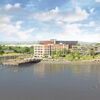'Economic lifeblood' at risk without needed southern Maine dredging projects
U.S. Sens. Susan Collins and Angus King were joined by U.S. Rep. Chellie Pingree in penning a letter to the U.S. Army Corps of Engineers urging the federal organization to move forward with critical dredging projects for York Harbor and the Saco River, which the coalition called the economic lifeblood for many coastal communities.
In the letter to the Army Corps, the coalition wrote that since the last dredging of York Harbor in 1996, some 42,000 cubic yards of sand, silt and clay that have accumulated in the harbor need to be removed. The call for action on the project was strengthened nearly two years ago when the New England District of the Army Corps of Engineers stated that significant shoaling in York Harbor is “hindering navigational access and compromising vessel safety,” and that inaction “would allow existing conditions to remain and worsen as shoaling continues.”
York has secured all the necessary permits to remove this material, according to the coalition, and its project has been shovel-ready for over a year. According to the New England District, York would most likely need to reapply for these permits and foot the high financial costs of the process again if the $2 million to $3 million project is not funded this fiscal year.
37 homes lost from erosion
The towns of Saco and Biddeford also completed the permitting process necessary for a dredging project on the Saco River that is estimated to cost approximately $3.2 million. The Saco River was last dredged in 1993 and more than 150,000 cubic yards of sand have built up since then, according to the letter to the Corps of Engineers.
Erosion is also a concern at Camp Ellis Beach in Saco, which needs clean sand to combat ongoing erosion that has already destroyed 37 homes, the coalition wrote in its letter. That sand would come from the Saco River dredging project.
“The law requires the Corps to consider factors other than tonnage transiting through a harbor, to include potential for regional or local economic development,” Collins, King and Pingree wrote in their letter. “In this respect, commercial activity on the Saco River — home to more than 40 commercial fishing vessels — contributes more than $53 million in economic impact to the community each year, and York Harbor produces a direct economic benefit of $12 million annually.”
Read more
Salmon effort seeks to restore important fishery
UMaine scientists use tech to see-the-unseen in potential aquaculture sites










Comments